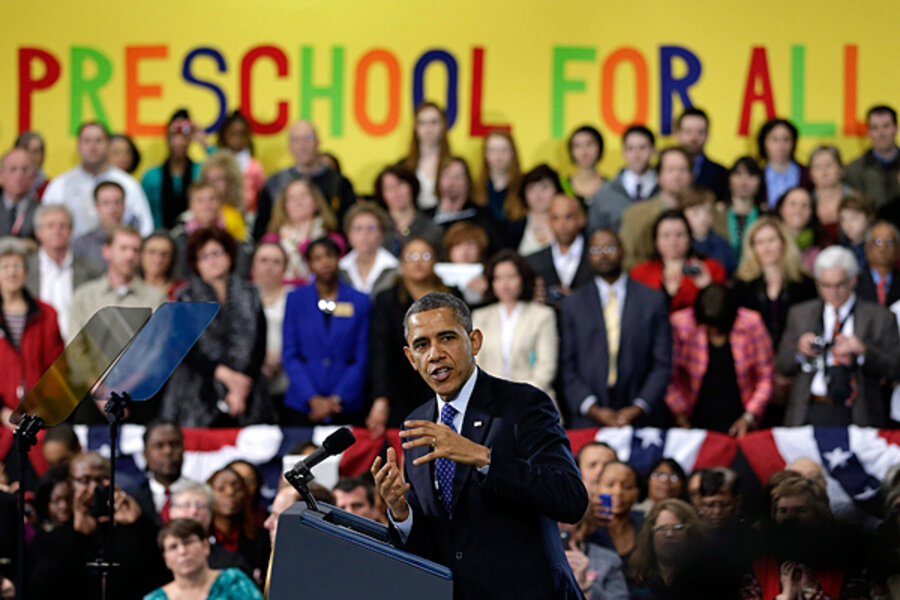From preschool to high school, Obama seeking big progress in education
| Boston
President Obama laid out an ambitious agenda for improving American K-12 education this week, linking the issue to the nation’s future prosperity.
During his State of the Union address Tuesday, Mr. Obama said he wants to make public preschools available to all four-year-olds in the US, a goal he then underscored Thursday with a visit to an early childhood learning center in Decatur, Ga..
"We know it works," he said at the school. "If you're looking for a good bang for your educational buck, this is it right here."
His Tuesday speech also promised a new effort “to redesign America’s high schools so they better equip graduates for the demands of a high-tech economy" and a plan to develop a “college scorecard” to help young people gauge the costs and benefits of attending a particular college.
The success of the president's lofty goals, however, will depend in large part on how successful he is at fleshing out his agenda and selling it to states and a politically divided Congress.
But some education experts say his proposals are at least a step in a positive direction – given the agreement that “human capital” is vital in an increasingly knowledge-based global economy.
“His goals are the right ones,” says Jack Jennings, founder of the Center on Education Policy, an independent advocacy group on education, which draws its funding from charitable foundations. “We lack comprehensive school reform in the United States,” he says, adding that Obama’s objectives bring some crucial educational issues into the public spotlight.
Preschool, for instance, can be vital stepping stone that prepares children for success in elementary school. And rebooting high school curriculums could make a big difference in the nation’s economic and social life.
Currently, only 34 percent of American fourth-graders and 30 percent of eighth-graders are at least proficient in science, according to 2011 data from the National Assessment of Educational Progress.
For high schoolers, the results are even worse: Just 21 percent of high school seniors ranked as proficient.
It’s significant, Mr. Jennings says, that Obama stepped over a traditional boundary line for presidents, stating in blunt terms that what is taught in US high schools needs to change.
Obama said that part of the change should be to offer stronger career-oriented education, citing the way German schools graduate “their high school students with the equivalent of a technical degree from one of our community colleges.”
The president's goals won't be easy to reach, given that his second-term attention span appears to be spread among many priorities, from deficit reduction to immigration reform to gun control.
Some analysts of the US education system say, moreover, that Obama still isn’t putting forward a coherent overall policy.
Diane Ravitch, a research professor of education at New York University and former assistant secretary of education, called Obama’s idea of preschool for all “strong and persuasive,” but wrote on her personal website that the president appears to be taking a tight-fisted approach to higher education funding, just as states have also been shifting burdens onto students.
In part, Obama's call for colleges to do more to cut costs reflects public exasperation at the way tuitions have continued rising even as graduates face a tougher job market.
Obama may also be choosing his battles and priorities. The Democratic president likely won’t have an easy time getting legislation through a Republican-controlled House of Representatives.
For his part, Jennings predicts that Obama will probably be able to at least win “down payments” from Congress on his latest education agenda.
That, in turn, could have sizable ripple effects. As in his first term’s Race to the Top challenge to the states, Obama is seeking to use federal dollars to offer incentives for states to take their own actions.
A White House fact sheet this week describes the preschool initiative as "a cost sharing partnership with all 50 states, to extend federal funds to expand high-quality public preschool to reach all low- and moderate-income four-year olds from families at or below 200% of poverty." The proposal also encourages more states to offer full-day kindergarten.









